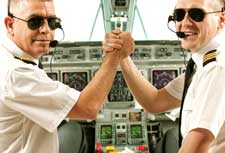Human Factors Central Theme in Aviation Safety

As the aviation industry continues to grow, a concentrated effort on safety needs to expand into all realms of aviation, especially regarding hazard identification, as well as risk assessment and mitigation, related to human error.
In aviation, there will always be uncontrolled variables. This remains true because we operate in an open system, exposed to many variables outside the direct control of the operator.
A leading factor in the vast majority of aviation accidents is human error. This begs the question, how much effort should be put towards identifying the tendencies for improper human performance and addressing these beforehand?
Related Articles on Human Factors in Aviation SMS
- Let’s Talk Human Factors - Origin of Dirty Dozen
- Human Factors: Lack of Teamwork
- Let’s Talk Human Factors: Distraction Is #4 of the Dirty Dozen
Aviation Safety Management Systems (SMS) Identify Potential Errors
From the largest to the smallest airports, and from global aviation corporations to small businesses, safety management systems (SMS) should be implemented by and large. For each component within aviation, an emphasis should be on identifying and preventing human errors.
Every accident that traces back to poor decision-making and judgments had recognizable risks. As a result, it is possible that most accidents could have been avoided had the symptoms been recognized and handled appropriately.
Error Prone Pilots Have Identifiable Traits
Human error is the result of natural tendencies and learned behaviors. Naturally, there is an element of the subconscious involved, which cannot be explicitly identified or trained. However, there are elements to be noted and addressed that do aid in decision-making and proper judgments.
According to the FAA, recognizable traits in pilots who are more prone to accidents include:
- disdain toward rules,
- seeking “thrills and adventures,”
- bent towards impulsivity rather than a methodical course of action, and
- sense of independence from outside sources of information, on the ground and in the air.
These traits are noticeable within the aviation community yet often too difficult to address. An alternative approach is to reinforce the value of proper judgments and the importance of risk identification.
Emphasizing the traits of successful pilots emphasizes the positive rather than just addressing the negative.
Importance of Knowing Limits
Not long before I started my flight training, a local pilot crashed after an engine failure on takeoff. Sadly, both he and the passenger on board were killed when the plane crashed down beside the runway.
I clearly remember my flight instructor talking me through the accident and the tragedy of human error involved. Once the engine failed, the pilot attempted to turn back around and land on the runway. Unfortunately, there hadn’t been enough time and distance to turn the plane around, and it crashed short of where the pilot intended.
This circumstance taught me the value of knowing the performance and limits of the aircraft at all times during the flight. It is sad to think both the pilot and the passenger could have survived the crash had the plane been guided straight ahead rather than crashing during a turn.
Related Articles on Human Factors in Aviation SMS
- 5 Things to Know About Aviation SMS Human Factors
- Let’s Talk Human Factors - Lack of Communication
- Let’s Talk Human Factors - Lack of Knowledge
Successful Risk Management Stems From Hazard Identification

One habit of a successful pilot is his or her identification of:
- hazards,
- limitations and
- risks involved.
Unless these risks and hazards are properly identified, prevention of them is unlikely.
In aviation, for each and every flight, it is important to examine:
- the pilot in command;
- the aircraft;
- the environment and
- external pressures (PAVE).
If this habit becomes ingrained, it allows oneself the opportunity to respond appropriately. This form of prevention can be taught in all areas of aviation, starting from initial training.
Have You Read
- How to Use PAVE Checklist for Aviation Risk Management
- 4 Tips to Approach Hazard Identification in Aviation SMS
- Understanding Role of Hazard Identification Training and Safety Reporting Forms in Aviation SMS
Future of Safety Management Systems
Safety promotion can take on many forms, including:
- Safety surveys;
- Safety newsletters;
- SMS training courses; and
- Lessons learned libraries.
Identifying human tendencies and natural reactions can aid in making suitable judgments. Identifying these elements is only part of the puzzle. They must also be communicated throughout the aviation industry to be effective in mitigating the associated risk.
As the culture of safety management systems (SMS) changes and the awareness of human error in accidents becomes more widespread, future accidents can be avoided. Safety management systems should focus on the increasingly important aspect of hazard and risk identification and self-awareness as the aviation industry continues to expand.
Aviation service providers' core SMS tools are their Safety Reporting System and their Risk Management System. Without an easy, confidential, and secure manner of reporting hazards, employees will never trust SMS. In addition, safety teams need user-friendly tools to document SMS risk management processes for up to five years.
Do you need user-friendly SMS database tools to manage SMS documentation requirements? Learn how SMS Pro can save your team considerable time and energy managing your SMS. These short demo videos will show you the possibilities.
Last updated March 2025.





